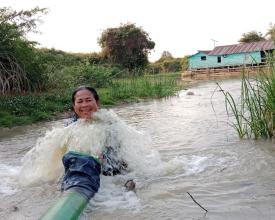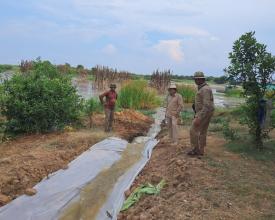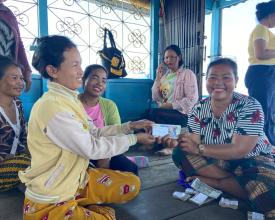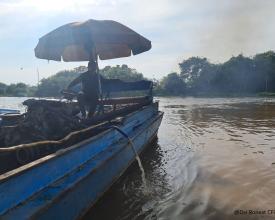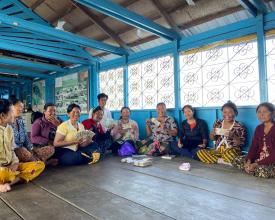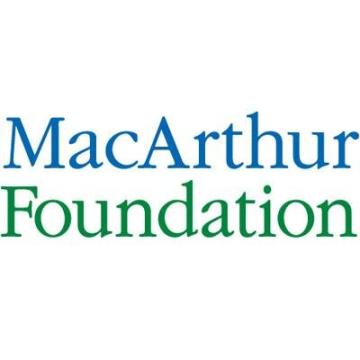Conservation Finance for Community Fisheries in Cambodia

Cambodia’s inland fishery is one of the world’s largest and provides food and livelihoods for millions. Over 500 Community Fishery Organizations (CFi’s) - local fishers with a government mandate - nominally manage over 1 million hectares of fishery resources. Unfortunately, even among the few CFi’s that function well, most are underfunded. Reliance on limited funds from their members and external grants results in sporadic CFi management. Conservation International has provided 15 CFis with conservation trust funds and supports Women’s Saving Groups with capital grants. Each CFi’s US$5000 trust fund is invested as an interest generating term deposit. Saving group grants range from US$1000 – 1500 and are loaned out to members to support their small business activities. The interest of both the CFi and Saving group grants provides CFi’s with a consistent supply of funds that allows them to manage their local fishery resources.
Context
Challenges addressed
Most Community Fishery organizations in Cambodia lack the resources needed to manage their local fishery resources. Not having a stable source of funding means that the CFi Committee cannot implement their management plan between gaps in external funding. This, particularly through reduced patrolling, can increase illegal activity such as flooded forest destruction and illegal fishing. Reversing their previous gains in managing their local environment and a loss of impetus and momentum amongst the management group.
Location
Process
Summary of the process
The three building blocks are complimentary. The success of the Women’s Saving Group Conservation Funds requires a close working relationship between the Women’s Saving Group and their allied Community Fishery Organization committee. Thus, both must have the capacity to competently and transparently manage these funds and their proceeds (Blocks 1 and 2). Similarly, the success of both the CFi’s and Women’s Saving Group requires them to collaborate closely with local government authorities (all three blocks).
Building Blocks
Community Fishery Committee Capacity Building
Prior to receiving funds, the Community Fisheries Committee must demonstrate a high level of management capacity. The CFi committee needs to be able to convene and record meetings, hold elections, and be financially transparent and accountable. The committee also needs the skills to work with local authorities and understand the legal framework within which they operate. These skills are provided through a mix of training and long-term support and mentoring.
Enabling factors
Building Community Fishery Capacity requires the CFi Committee:
- To be properly structured and active;
- The CFi has undertaken financial management training;
- Has a bank account; and
- Has demonstrated their ability to transparently and accountably manage funds.
Lesson learned
In building Community Fishery Committee capacity, we have learnt that:
- The CFi Committee requires mentoring and support in building a working relationship with their local Women’s Saving Group.
- The often exclusively or majority male CFi Committee can find it difficult to overcome gender bias to respectfully request funds from the Women’s Saving Group and adhere to the requirements of the funding – such as providing timely written reports and receipts.
- Gender in NRM training provided to CFis has helped overcome gender bias.
Women’s Saving Group Capacity Building
Each Women’s Saving Group must achieve a high standard of financial literacy and management capacity prior to receiving a Conservation Fund. These skills are required before they start to loan the Conservation Fund capital to their members and then provide their local CFi with the interest generated to fund conservation activities. Capacity building for Women’s Savings Group members includes training in managing credit, building a business, understanding contracts, and keeping a savings book. The Women’s Savings Group Committee will also be trained in meeting procedures, record keeping, bookkeeping, managing savings books and understanding the group bylaws.
Enabling factors
Building Women’s Saving Group Capacity requires:
- The Women’s Saving Group Committee must be committed to the success of the savings group.
- The Women’s Saving Group leaders must actively participate in developing group rules and regulations. And then follow them as an example to other members.
- Women’s Saving Group leaders must be able to prepare clear and transparent financial reports.
- Before establishing a saving group or engaging with an existing group it is important to conduct a baseline survey to gauge community understanding of savings concepts. For existing groups, it is important to assess their current committee structure, rules, regulations and operations.
- Training group members on subjects including credit, building a business, paying back debt, and loan contracts.
Lesson learned
In building Women’s Savings Group capacity, we have learnt that:
- Engaging respected village leaders and local authorities (i.e. Village Chief or Commune Council) in overseeing the operations of the Women’s Saving Group increases the likelihood of the group being successful.
- Group members need to be taught how saving groups improve household economics, food security and generate income.
- Saving groups can reduce the reliance of local villagers on unsecured high-interest rate loans
- Saving groups can reduce poverty by providing lower interest rate loans and through educating members on the importance of savings.
- Participation in the saving groups builds trust, confidence, and empowerment among the group members.
Government Engagement
As both the Community Fishery Conservation Trust Funds and Women’s Saving Group Conservation Funds contribute to CFi activities, it is important to engage with local government authorities to gain their support and leverage their involvement. Community Fisheries operate under a government mandate and are overseen by local Fisheries Administration authorities, who ensure that CFi activities follow both internal and national rules. Involving the Commune authorities in managing Women’s Saving Group operations helps to reduce potential sources of intergroup conflict, increase trust between members, and strengthen group management. Women’s Saving Group members respect the involvement of the Commune and are mindful of its oversight. Furthermore, some Commune’s have granted additional top up grants to Women’s Savings Groups who have performed well.
Enabling factors
Facilitating government community relationships requires:
- A trusting relationship between the community and local government authorities.
- Properly constituted and officially recognized Community Fishery Organizations and Women’s Saving Groups;
- Well managed Community Fishery Organizations and Women’s Saving Groups
Lesson learned
In facilitating government community relationships, we have learnt that:
- CFi’s with their own funds facilitate additional contributions from the local authorities. It is common that neither party has the capacity to fully fund an activity, but they can both provide a contribution. For example, some CFi’s have purchased a boat engine and the local authorities have donated a boat that had been confiscated for being involved in illegal activity.
- CFi’s with their own action plan and finances are better able to secure the limited support able to be provided by local government authorities.
Impacts
In 2014 we began implementing our system of conservation finance in fifteen Community Fishery Organizations in Cambodia. Since then, we have established twelve US$5000 Community Fishery Conservation Trust Funds. These funds have generated US$21,993 to support CFi activities including patrolling for illegal activity, guarding their dry season fish refuge ponds and improving these fishponds through increasing deep pools and providing fish habitat. We have also granted eighteen women’s saving groups a total of US$38,000 in capital grants. These funds have generated US$21,891 in interest, of which US$ 9,292 has been granted to their local CFi’s to implement their management plans.
Beneficiaries
Members of 15 community fisheries, 18 Women’s Savings Groups and their families, are the primary beneficiaries of our approach through improved fisheries management. There are environmental benefits as around 300 species of fish and their habitat is preserved.
Sustainable Development Goals
Story
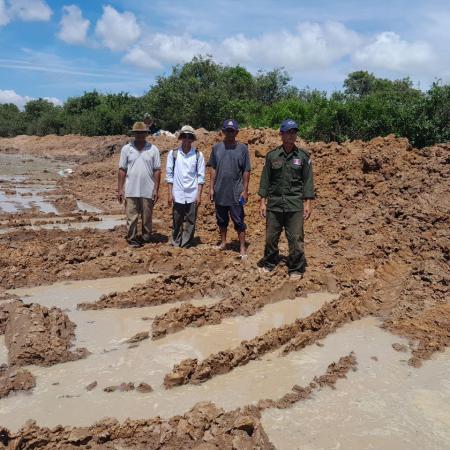
Funding from the Ou Ta Prok Community Fisheries Conservation Fund and Satrey Sansam Brak Ou Ta Prok and Satrey Aphivat Ou Ta Prok Women’s Savings Group Conservation Funds allowed Ou Ta Prok Community fishery to deepen their community fish conservation pond. The CFi committee used two years of interest generated by the CFi Conservation Fund (US$500) and Women’s Saving Group Conservation Funds (US$250 from each group), along with US$835 in cofinancing from the commune, CFi members, and local community to excavate their community fish conservation area. Using a tractor the CFi increased the pond’s depth from less than 1.5 meters to between 1.5 and 2 meters. The CFi hopes that up to five tonnes of fish can find refuge in the deeper waters, up from the two tonnes found before the excavation. They also hope to increase the diversity of fish from 19 to 24 species – matching the species richness of other deeper fish conservation ponds found around the lake. This demonstrates that both CFi Conservation Trust Fund and Women’s Saving Group Conservation Fund can significantly aid in planning and achieving long-term fishery conservation goals.

